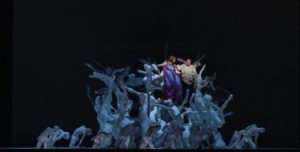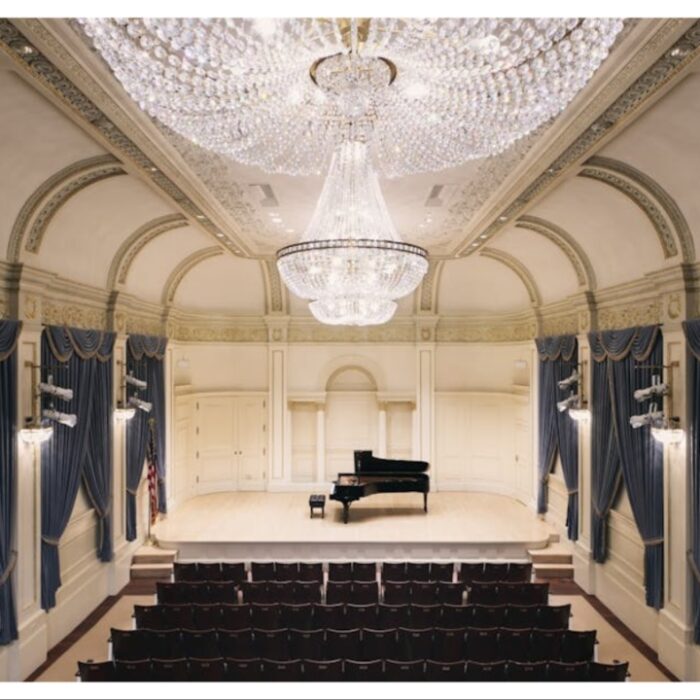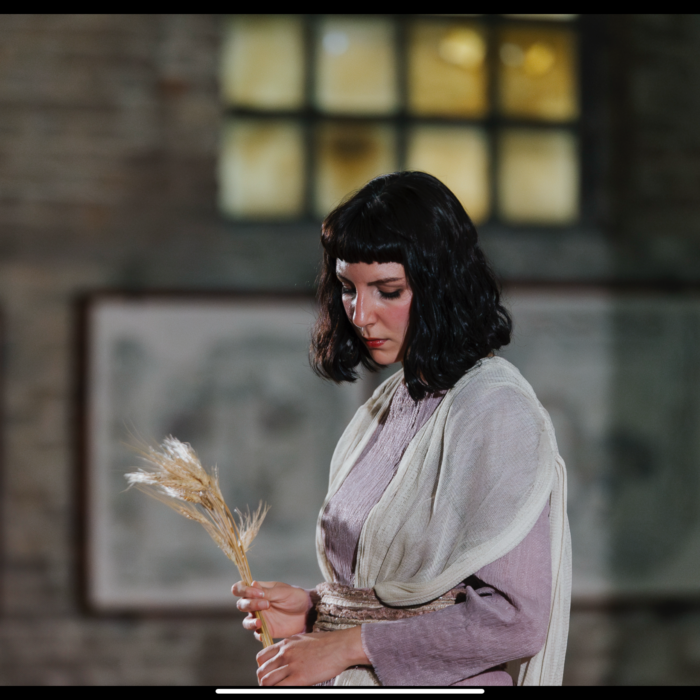
Teatro Comunale Di Bologna 2020 Review: Tristan Und Isolde
Catherine Foster & Bryan Register Star In Ralf Pleger’s Representation Of The Unconscious
By Alan Neilson(Photo: Rocco Casaluci)
Of all the operas ever written possibly none explores the unconscious drive of love with such a stark and uncompromising vision as Wagner’s “Tristan und Isolde.” It is not a love tainted by the individual psychologies of its participants, their behavior is not an outcome of a deeper pathology, or molded by the past events which have shaped them. Their love is primal, seated at the core of what it is to be human. There is no moral dimension to it, and is unconcerned as to what society may have to say. It is an all-consuming force which dictates. To deny it is to reject the human condition itself. It is selfish and selfless at the same time, a contradiction which only death can resolve, for only by leaving the confines of the body can two become one, can one fully consume and be consumed by the other.
The question, of course, is how can this be staged, how can the unconscious, which is perceived yet not bounded by reason, be brought to the stage in a manner which is understood by the audience? A simple telling of the narrative will gloss the surface, but is unlikely to reflect the profundity contained in Wagner’s ecstatic music.
An Internalized Production
The director Ralf Pleger, and his scenographer Alexander Polzin, did not shirk from the challenge, and produced a staging which attempted to represent and communicate the unconscious mind directly. Thus, the audience was exposed to an internalized version of the drama, in which anything external was removed, it being only a distraction to the meaning and the momentum of the interpretation. Obviously, therefore, there was no sign of a ship in the first act, and the potion was redundant, which in any case was always only a means to removing the moral dimension from the lovers’ suspect actions. Instead the staging was given a distinct design for each act, in which transparent and opaque symbols, color, movement and ambience were used to transmit meaning. However, it was not necessary for the audience to focus on, nor to have a reasoned understanding of every detail, rather it was encouraged to engage with the subliminal effect, and allow the unconscious minds of the lovers to reveal themselves.
The setting for Act one was a largely dark empty stage with stalactites, hanging like icicles from above, which grew as the act developed, and which by the end of the act were almost touching the floor. The ambience was cold, and helped to distance Tristan and Isolde from each other. At the point in which their feelings change, and love asserts itself, the central stalactite changes from cold white to hot red.
The central act was stunningly presented, and although the intellectual meaning was unclear, it had an unambiguous impact. In the center of the stage was a large entangled mass of what appeared to be the uncovered roots of a tree, which rotated occasionally on a revolving stage. Tristan and Isolde, as well as the other cast members, weaved their way through the structure, sometimes disappearing, sometimes climbing it, and used it to exit or enter the stage unnoticed. It was dimly lit. Then unexpectedly, it came alive. Many of the roots were in fact people who began moving slowly about the structure, adopting a variety of stylized movements and poses. It was against this background that the love duet, the work’s centerpiece, took place.
The final act was dominated by a light and shadow display, created by lighting director John Torres. Light shone down poles which extended and retracted into holes on a large back screen, allowing the coloring and light of the stage to maintain an ever changing ambience, sometimes appearing as starry night sky, at other times allowing the creation of a variety of shadows. Again, the meaning existed beyond the rational.
They were strongly shaped sets in which everything was clear, even if the specific meanings were only partially glimpsed, successfully reflecting our relationship with our unconscious.
Pleger was always careful to emphasize his vision of the work as an essentially internalized drama, by keeping the Tristan and Isolde physically separate. They rarely touched each other. The central love duet was delivered by the lovers looking towards the audience, not at each other, and certainly not in each other’s arms.
The costumes designed by Wojciech Dziedzic suggested no defined time period, if anything they contained a futuristic element to their design. On the whole they were largely successful in adding to the lack of specificity and were aesthetically pleasing; Brangäne’s angular looking costume was particularly fine.
Musically Solid
Musically, the conductor Juraj Valčuha produced a clearly defined, precise reading from the Orchestra del Teatro Comunale di Bologna, which captured the silky textures of the score. It was also a detailed performance, one which was attentive to balance, dynamic movements and contrast and finely judged tempi. Valcuha was particularly successful in managing the score’s ebb and flow, expertly building and releasing the tensions to promote the dramatic impact. If there was one minor negative criticism, it was that maybe the performance lacked a degree of passionate abandonment.
In the role of Tristan was tenor Bryan Register. He gave a strong, precise vocal performance, marked by its level of consistency, which even in the demanding third act, with its succession of arias, “Dünkt dich das?” “Mein Kurwenal,” and “O dieses Sonne” showed no signs of tiredness or strain. Throughout, his phrasing was subtly crafted, making full use of dynamic inflections, colorful shadings and neatly placed accents, which created an expressive reading. Although in line with the overall musical and dramatic presentation, the performance lacked a degree of frisson, Register’s vocal precision dampening the passions; his acting, at times, too introspective to set the pulse racing. These were, however, clearly artistic decisions taken to promote the overall vision of the presentation.
He was partnered by soprano Catherine Foster, Bayreuth’s 2017 Brünnhilde, as Isolde, who produced a vocally gripping performance. Singing throughout with a freedom which was tangible, she engaged fully with the character, whom she portrayed with a regal demeanor. Her vocal timbre has a metallic quality which shone brightly with unsupressed passion in the upper register. The voice is also a marvelously flexible and powerful, which stretched upwards without any loss of quality, always fully under control and able to rise above the orchestra with apparent ease. Yet it is also a voice of beauty, which she used expertly to express her complex array of emotions. The first act aria, “Wie lachend sie,” in which she captured her conflicted feelings for Tristan, was expertly delivered, her voice leaden with emotional depth, taking in leaps with ease, and hitting the high notes with power and quality. Of course, Foster also has the good fortune to bring the opera to an end with the “Liebestod,” for which she gave an energetic and suitably engaging rendition, which brought loud applause from the audience. As with Register, her acting was relatively restrained.
The role of King Marke was undertaken by bass-baritone Albert Dohmen. He drew a nuanced portrait of the King, whose understanding and humanity he expertly depicted. It was a confident, self-assured performance founded upon his solid technique and the attractive quality of his voice. He possesses a colorful palette, with a notably engaging rough texture in the lower register. His phrasing was cleverly wrought. His Act two aria, “Tatest du’s wirklich” caught the attention, which was given an expressive and secure rendition, in which he reflected upon his feelings for Tristan: the pain, the love, the betrayal, the sadness, Dohmen captured them all.
The mezzo-soprano Ekaterina Gubanova has a beautifully clear, clean sounding voice, which she burnishes with an array of colors. It is consistent across the range, her articulation is even and precise, and for most of the performance was excellent in the role of Brangäne, whom she portrayed as a somewhat distant character. Towards the end, however, there were signs of tiredness in the voice which started to waver a little.
Martin Gantner made a strong impact in the role of Kurwenal. He has a very distinctive stage presence and a baritone with pleasing tone, underpinned by a secure technique. His aria, “Das sage sie,” was given an expressive reading, full of character, in which his indignant defense of Tristan was forcefully sung. Recitatives were well-crafted, displaying a high degree of vocal plasticity.
The baritone Tommaso Caramia displayed considerable versatility. Parted in two roles, Melot and the Steersman, he was able to provide distinct and well-defined portrayals. His singing was even toned, expressive and forceful.
Likewise, the tenor Klodjan Kacani also showed versatility essaying the roles of the young seaman and the shepherd. He showed quality, producing precise, clear and articulate performances.
Pleger’s presentation was ambitious and intriguing. At the final curtain the audience showed its approval with enthusiastic applause, although it is not a production that would necessarily appeal to everyone. The arcane nature of the staging may easily act as distraction to audience members determined to decipher its meanings, and the restrained presentation of Tristan and Isolde’s passion may have been a disappointment to some. What could not disappoint, however, was its musical quality, led by Valčuha and the Orchestra del Teatro Comunale Bologna, accompanied by its strong cast of singers.



